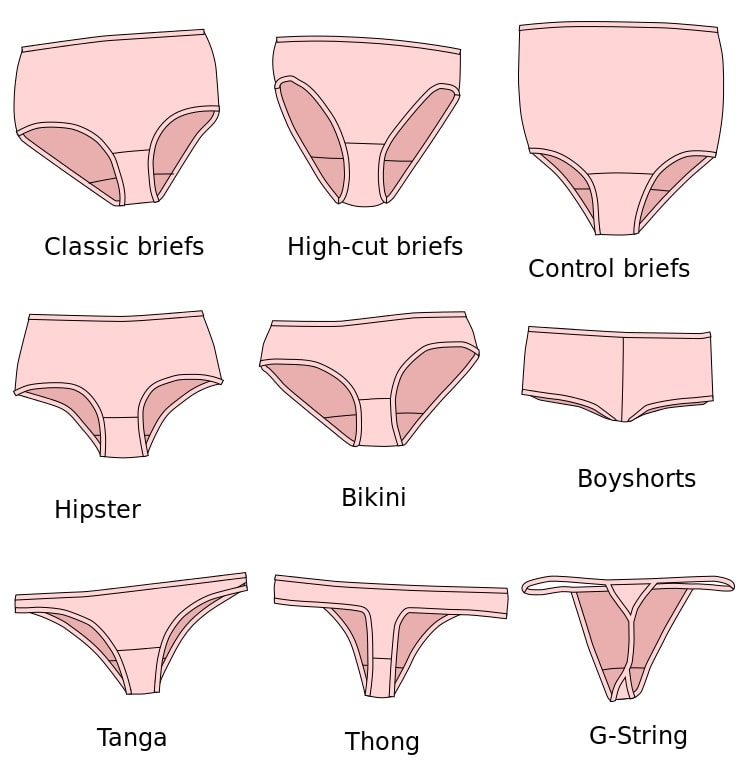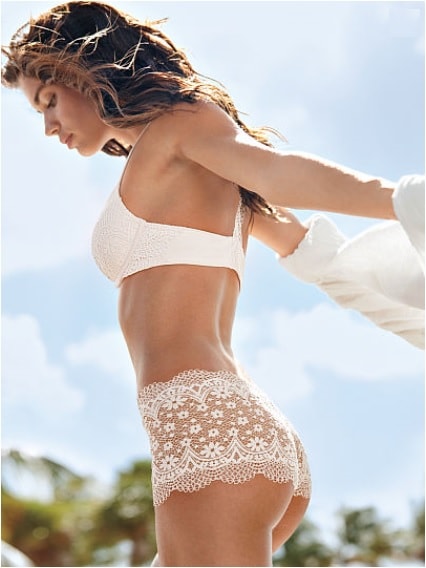
Panties
Panties in American English are a form of underwear worn by women. Panties are plural and Panty is singlular.
Panties are most often form-fitting, but may also be loose.
Typical components include an elastic waistband, a crotch panel to cover the genital area (usually lined with absorbent material such as cotton), and a pair of leg openings that, like the waistband, are often made of elastic.
Panty Fabrics
Various materials are used, but are usually chosen to be breathable. Some manufacturers will use anti-microbrial fabrics. Panties are made of a variety of materials and fabrics, including satin, silk, PVC, cotton, nylon, mesh, lace, rawhide, leather, latex, lycra, and polyester. Construction typically consists of two pieces (front and rear) that are joined by seams at the crotch and sides; an additional gusset is often in the crotch, with the waistband and leg-openings made from elastic.
Panty Styles
Panties are classified into various styles based on criteria such as the amount of rear coverage, width at the sides and height at which they are worn. These categories are not necessarily distinct and usage may vary somewhat among brands:
Briefs rise to the waist, or just below the navel, and have full coverage in the rear. Briefs are a type of short, snug underwear and swimwear, as opposed to styles where looser material extends down the thighs. Briefs were first sold on January 19, 1935 by Coopers, Inc., in Chicago, Illinois at Marshall Field's department store. They dubbed the new undergarment the "Jockey" because it offered a similar degree of support as the jockstrap (one style of which is also called jock brief or support briefs).
Classic briefs feature sides that extend below the hip. Sometimes these are called "granny panties" by young women. Learn more about granny panties in our fashion terminology section.
High-cut briefs are designed with sides that are somewhat narrower.
Control briefs are designed to offer support while giving a slimmer appearance. This type usually contains a stretch material such as spandex and may extend above the waist.
Hipsters are worn lower down on the body, with the waistband around the hips.
Boyshorts (or boyleg) are styled after men's boxer briefs and have short legs extending below the crotch.
Bikinis sit at hip level, like the hipsters, but the fabric of the side sections is narrower. With the string bikini type, the side sections disappear altogether and the waistband consists of only string-like material; also, the rear coverage of the bikini is more revealing than that of the brief. A bikini is usually a women's abbreviated two-piece swimsuit with a bra top for the chest and panties cut below the navel. The name for the bikini design was coined in 1946 by Parisian engineer Louis Réard, the designer of the bikini. He named the swimsuit after Bikini Atoll, where testing on the atomic bomb was taking place.
Tangas provide a moderate to minimal coverage with back coverage that is less than a bikini, and the waistband is reduced to a narrow strip at the sides. Viewed from the front, the thong typically resembles a bikini bottom, but at the back the material is reduced to a minimum.
Thongs have a waistband similar to tangas, but the rear coverage is mostly cut away. The crotch is extended to the back of the wearer and a narrow strip of fabric fits between the buttocks, becoming wider towards the top. One type of thong is the G-string.
The G-string has a vertical string at the back, which connects the crotch to the waistband, sometimes featuring a triangle of fabric. A G-string is a type of thong.
Here is a panties style cheat sheet that shows various examples:

Learn more about different types of underwear in our underwear glossary.
History of Panties
The earliest known use of underwear that resembles modern panties dates back to 4,400 B.C. during the Badari period in Egypt. Statuettes found in Badari tombs show the modern panty as we know it today: triangular in shape with very little cloth around the hips. Most modern cultures have created their own style of underwear, but modern panties closely resemble those that adorn Badarian statuettes.
While panties were at one point in history designed to cover the entire lower half of the female torso (a long time ago). Not sure if pantalettes could technically be considered panties or not. Pantalettes were undergarments covering the legs worn by women, girls, and very young boys (before they were breeched), in the early- to mid-19th century. Pantalettes originated in France in the early 19th century, and quickly spread to Britain and America. Pantalettes were a form of leggings or long drawers.
In more modern times panties have had either no legs or, in some cases, very short ones, and have become increasingly smaller over time.
In British English panties or underwear are typically called knickers. In many countries they are also referenced as undies, bloomers.
Panties can be dyed a solid color or printed with various designs. Some panties are made with novelty prints to show humor, team spirit, or other aspects of ones sense of style. Certain fabrics, colors, and styles make the wearer more appealing to men. If you want to know which colors & styles are most appealing, you may have to do some research on your own.
Learn about other types of underwear & lingerie styles.
Retailers of possible interest:


Fashion Products Fashion Products M-R Fashion Product P
Return to the Influence Fashion
home page.
Copyright 1999-2017
Apparel Search Company. All
Rights Reserved.